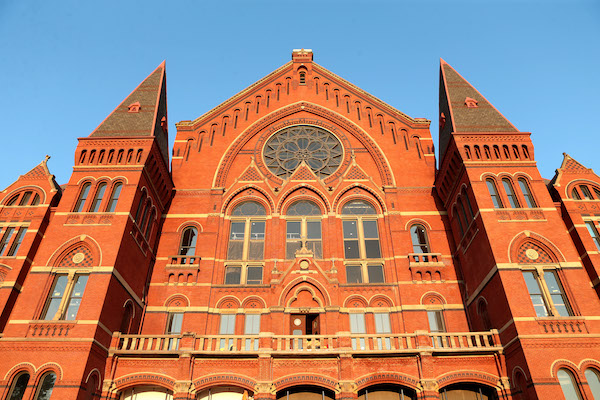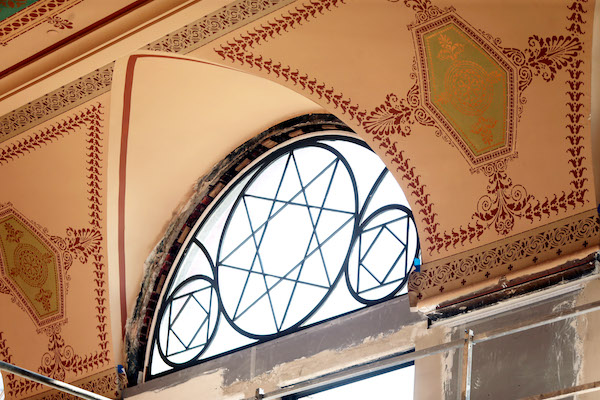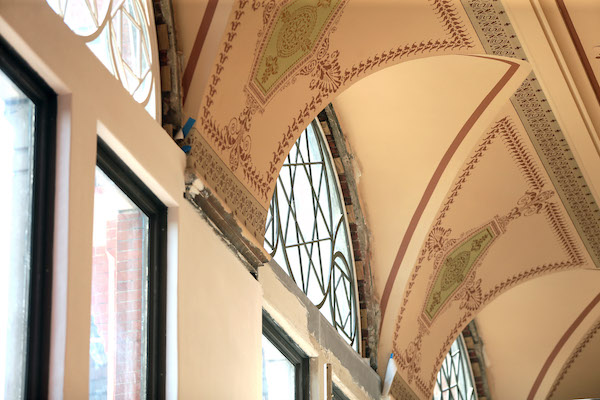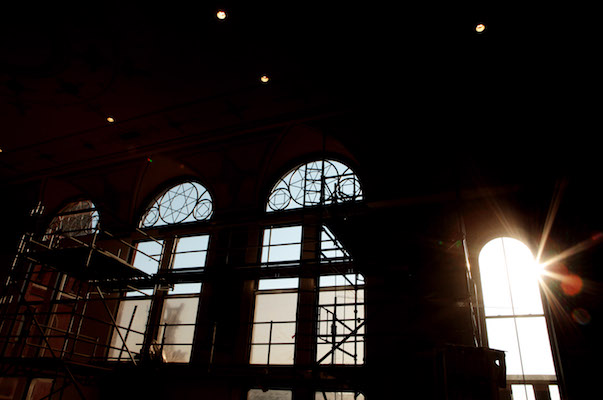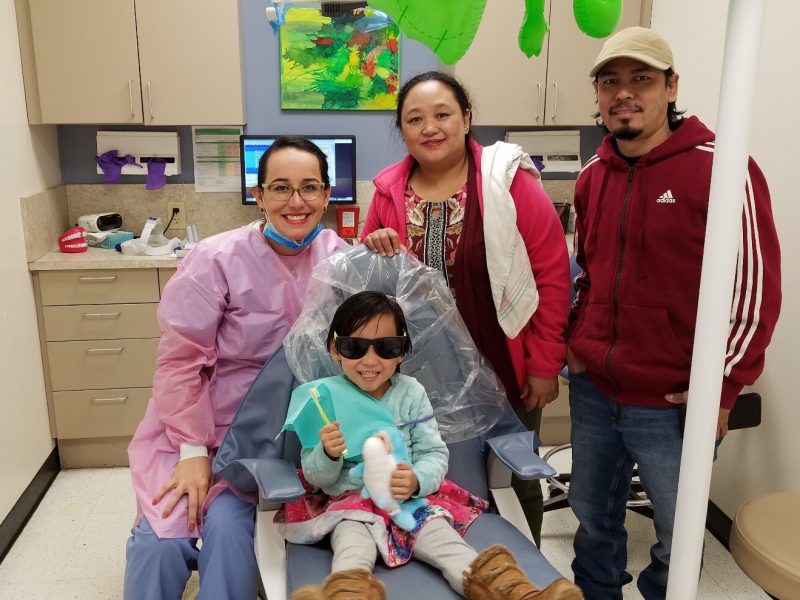Cincy Sets the Stage: Restored Corbett Tower, historic gem of Cincinnati Music Hall
Take a step back in time with this detailed look at the refurbished Corbett Tower, a historic gem in iconic Cincinnati Music Hall, which reopened this past weekend to much fanfare and excitement.
Of course, classical music fans are jazzed about getting back into the newly revitalized Cincinnati Music Hall. They are eager to see what’s changed and how the renovations will make for memorable arts and event experiences for years to come.
But even non-theater-going Cincinnatians are lining up to check out the beautiful improvements to the iconic building. Big crowds turned out this weekend for first looks and listens, as Music Hall officially reopened to the public.
While Springer Auditorium is the main attraction for orchestra, opera, choral and ballet performances that are now back in full swing, there’s a second space that’s also evoking rave reviews. In fact, the restoration of Corbett Tower is even more significant historically, and it represents a closer look at what Music Hall looked like when it opened in 1878.
Springer Auditorium, the main concert hall, has been downsized from 3,400 seats to 2,500 or so. (There’s some flexibility based on the configuration of seating and stage extensions.) It’s not the first time that space has been changed: When the building opened in the 1870s, it accommodated nearly 6,000 total, with seats and standing room (4,470) in a gigantic open space with a first-floor, wraparound balcony (1,000 seats) and second-floor balcony (400 seats).
Late in the 1890s, changes were made, including the addition of new first- and second-floor wraparound balconies and a formal stage proscenium (the frame around the performance area).
Over the hall’s first century, more changes were made, and the first major renovation in 1970 — an $11 million project that relied on more than $6 million in funding from philanthropists J. Ralph and Patricia Corbett — changed many aspects of the building.
But it’s good to know that some very specific and important history has been maintained, thanks to the support of the Society for the Preservation of Music Hall, which has invested more than $5 million total in restoration projects, with $3 million focused in a less familiar room.
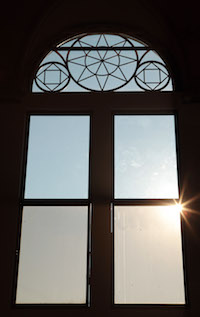
Retracing history in Hannaford’s original plans
Not everyone knows Corbett Tower. (Someone I spoke to recently assumed it was in one of the twin peaks flanking the building’s front façade.) It’s actually located two stories above Music Hall’s lobby, with a similar footprint to that spacious area. An SPMH event on Oct. 11, “Music Hall Unwrapped,” will show off the renovations there. In fact, intense interest in the space has resulted in the evening event being sold out for weeks.
Corbett Tower was originally called Dexter Hall, named for Julius Dexter, a 19th-century businessman and philanthropist whose fortune derived from his father Edmund’s liquor distribution business. An Ohio state senator, a gubernatorial candidate and a trustee on the 1870s Cincinnati Music Hall Association board, he chaired the building committee and was involved in hiring legendary Cincinnati architect Samuel Hannaford to design the building.
According to SPMH board member and historic preservationist Thea Tjepkema, Dexter Hall was considered the “small hall,” in relation to the much larger Springer Auditorium. Today, the space can be seen from Washington Park through three stately, restored arched windows — formerly covered over with bricks — that now feature “tracery,” or lacy mullion patterns, recreated from Hannaford’s original architectural drawings and from historic photographs. The windows are just beneath Music Hall’s central rose window.
The “small hall” was originally 46 feet wide and 112 feet long. It had a high, coved ceiling rising about 30 feet overhead. A stage at the south end was used for performances like recitals and chamber concerts. The room also provided space for conventions and expositions. Tjepkema says every Monday night in the 1870s and 1880s, the Harmonic Choral Society rehearsed there.
Victorian arts education in the hall
The College of Music of Cincinnati (CMC) was founded inside of Music Hall in 1878 and rented Dexter Hall for performances, with audiences sometimes approaching 800 attendees. CMC moved into its own building next door to Music Hall in 1882.
“In fact, the College of Music was all over Music Hall,” Tjepkema says, “for three years until they started building their campus on what’s now the parking lot between Music Hall and Memorial Hall on Elm Street.”
Even after it had its own performance spaces, the Odeon and Lyceum, the college continued to use Dexter Hall regularly.
In the 1890s, Dexter Hall’s white-plastered walls were redecorated, probably by John Rettig, according to Tjepkema’s research. He was an artist who studied under Frank Duveneck at the Art Academy of Cincinnati, who became known for frescos and stenciling. His artwork was featured in many local private residences.
“He later became famous for the ‘spectacles’ he created — sets and scenery for huge dramatic works that were performed on Music Hall’s main stage and on the Miami and Erie Canal behind Music Hall,” says Tjepkema. “The first thing he did for sets and scenery at the College of Music was Rossini’s Cinderella in Dexter Hall, put on by students.”
Tjepkema describes the stenciling decorations of Dexter Hall as “late Victorian, which is very obvious by the late Victorian colors. It’s got vibrant teal, mixed with a dull wheat/penny brown, bamboo-shoot green and gold.” She says the latter is really beautiful with light streaming in the three uncovered windows, now with the aforementioned “tracery.”
An initial step in Music Hall’s renovation included removing a drop ceiling that was installed during the building’s 1970 renovation. It revealed the original stenciling, but the century-old plaster was seriously deteriorated and the stenciling could not be preserved. Instead, it’s been reproduced by EverGreene Architectural Arts, one of the country’s foremost experts in both traditional and innovative techniques for murals, ornamental plaster and decorative finishes. Its principal, Jeff Greene, a Cincinnati native, oversaw the meticulous process of re-creation.
“They documented all of the stencil patterns, did a paint analysis to make sure they found all the correct colors, then made a map of the ceiling and the walls where everything was,” Tjepkema says. “The stencil patterns were laser-cut out of Mylar, a kind of plastic. Just like the original artists would have done, they were up on scaffolding, taping the stencil pattern on the wall and painting on it by hand, just the way it was done in the late-Victorian era. The border patterns were laser-printed on canvas and applied liked wallpaper.”
The results are breathtaking, further enhanced by three glorious chandeliers that previously hung in the first-floor lobby. Those were not original to the building — these crystal light fixtures from Czechoslovakia were investments by the Corbetts in the 1970s — but they are a fitting addition to this room, which surely originally had gas and then electric illumination from three ceiling fixtures, as evidenced by the three ceiling stenciled medallions.
Dexter Hall doubled as a foyer for Music Hall’s upper-level gallery, which had two huge arched openings into this space. Alan Weiskopf, the PWWG Architects principal who oversaw the Music Hall project, says, “The public could enter directly from Springer Auditorium or from the north side (at the top of the grand staircase). There was just a little stage door on the south side. Doorways from the auditorium were actually discovered during the work, they were not part of the original work. We elected to express them on the Springer Auditorium side. It’s part of the story about how we’re going back a little closer to the history.”
“After the 1895 Hannaford & Sons rehabilitation, patrons could enter those two arched doors on the gallery level into Dexter Hall and use it as a lobby space for refreshments during concerts,” says Tjepkema.
They’re not connected functionally to the space today, but their existence is acknowledged.
In the mid-20th century, Dexter Hall spent several years as WCET’s first broadcast studio. America’s first licensed educational television station did its first live broadcast from the space in 1954. Until the Crosley Telecommunications Center became the PBS affiliate’s home across Central Parkway from Music Hall, Dexter Hall was part of WCET’s operations. Following Music Hall’s 1970 renovation, Dexter Hall became Corbett Tower.
Overcoming challenges of historic restoration
Tjepkema says she has not located any photos of the appearance of Dexter Hall. She adds that there’s only one 1950s photo of the space as a television studio. Accordingly, the search is on: Tjepkema and her fellow SPMH researchers are eager to recruit more enthusiasts to help with further documentation.
Another PWWG architect on the Music Hall project, Andreas Lange, says, “Our design has tried to keep the best existing fabric in place and restore it in the best manner possible. Springer Auditorium is a different generation than Corbett Tower. They’re separated by a couple of decades, but people read them as the same. In one space [Corbett] we’re restoring the aesthetic of the 1870s. In the other [Springer], it’s the 1970 renovation we’re restoring, not the original hall [from 1878].”
Lange’s colleague Weiskopf adds, “The architectural marching orders that we were asked to consider were largely not to try to recreate history for the rest of the building because it’s been manipulated so much over the years.”
But Corbett Tower is the one area where history and preservation have been given considerable weight, especially with the restored ceiling height, which returns the room to its original significant volume.
Corbett Tower is now, however, a museum. Some concessions to contemporary needs were made that enhance the room’s functionality for the 21st century. The light box where spotlights and tech staff are housed for Springer Auditorium project through Corbett Tower’s west wall. That wall also has a pair of video screens that can be hidden when not in use. A bar beneath the light box can be moved forward for special events or pulled back when it’s not needed. The masking for the light box includes acoustical materials (also in the ceiling), ensuring that music and other sound in the room is ideally presented. Wooden cabinetry along the front wall, beneath all the windows — now without curtains — hide heating and cooling duct work that’s been designed to be extremely quiet.
Carpeting with Victorian patterning has been laid down, but most eyes will be focused upward on the beautiful recreations of the late-Victorian stenciling. The sum of all this reflects a serious commitment to Dexter Hall’s original appearance. “Corbett Tower,” Tjepkema asserts, “is the one place in Music Hall where you can actually walk back in time and feel what it was like in the late Victorian era with stenciling in that grand, open space.”
Ed Rider, a member of SPMH’s volunteer board and a retired archivist from Procter & Gamble, says that the Society “had the opportunity to make restoration work possible thanks to funds from two Corbett endowments — Mrs. Corbett’s personal endowment and the closing of the Corbett Foundation. Those dollars were complemented by funds from members for various projects, for organizing and promoting tours and so on. Now that we have this restoration work, we’re looking at more and different ways to engage people — giving talks in the community, guiding tours of the building.”
He adds that a new SPMH website is in the works, as is signage in Washington Park featuring more information about Music Hall’s history.
“Music Hall is arguably Cincinnati’s most iconic building,” Rider says. “Over time it’s changed so much, so it’s important to bring back special historic features that have made it unique and interesting.”
He cites as one example, the restoration of carved wooden panels from Music Hall’s original Hook & Hastings pipe organ. Some 30 of these have been reclaimed and are now featured in the Taft Suite, a new donor lounge on Music Hall’s first floor.
Even though the “Music Hall Unwrapped” evening is sold out, you can still purchase tickets for other upcoming Music Hall events.
You will have plenty of opportunities for interested parties to enroll now for upcoming SPMH-guided tours of Music Hall’s interior, resuming in the weeks ahead. Corbett Tower, with all the beautiful trappings of Dexter Hall that dazzled audiences in the late 19th century, will be significantly featured on every tour. (The “Unwrapped” event was also conceived to build up SPMH membership. If you’re fascinated by the history of Cincinnati Music Hall, now is the perfect moment to join the cause: www.spmhcincinnati.org.)
Support for this Cincy Sets the Stage series is provided by the Society for the Preservation of Music Hall (SPMH).

